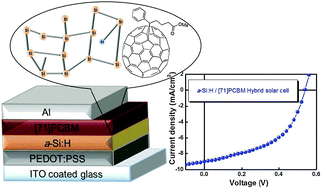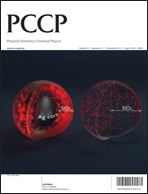A hybrid solar cell fabricated using amorphous silicon and a fullerene derivative†
Abstract
Hybrid solar cells, based on organic and inorganic semiconductors, are a promising way to enhance the efficiency of solar cells because they make better use of the solar spectrum and are straightforward to fabricate. We report on a new hybrid solar cell comprised of hydrogenated amorphous silicon (a-Si:H), [6,6]-phenyl-C71-butyric acid methyl ester ([71]PCBM), and poly-3,4-ethylenedioxythiophene poly styrenesulfonate (PEDOT:PSS). The properties of these PEDOT:PSS/a-Si:H/[71]PCBM devices were studied as a function of the thickness of the a-Si:H layer. It was observed that the open circuit voltage and the short circuit current density of the device depended on the thickness of the a-Si:H layer. Under simulated one sun AM 1.5 global illumination (100 mW cm−2), a power conversion efficiency of 2.84% was achieved in a device comprised of a 274 nm-thick layer of a-Si:H; this is the best performance achieved to date for a hybrid solar cell made of amorphous Si and organic materials.


 Please wait while we load your content...
Please wait while we load your content...